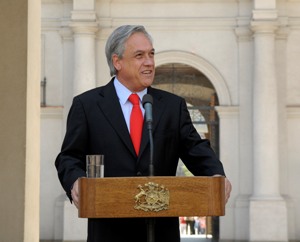
Chile Envisions Integrated Latin America
Power Grid
Latin America Herald Tribune, SANTIAGO, Jan 13.
2012
 President
Sebastian Piñera said his government’s efforts to promote a more transparent
and competitive electricity market will make it possible for Chile to connect
its power grid with those of other Latin American countries. President
Sebastian Piñera said his government’s efforts to promote a more transparent
and competitive electricity market will make it possible for Chile to connect
its power grid with those of other Latin American countries.
Both aims are part of his administration’s “eight-pillar” strategy to promote
the development of Chile’s electricity industry over the next 20 years, the
president said in a speech on energy policy Thursday at a convention center in
this capital.
Piñera also stressed the importance of achieving electricity interconnection
with neighboring countries, such as Argentina, under a legal framework that
offers guarantees to Chile.
The right-wing billionaire, who took office in March 2010, said the eight
pillars also include promoting non-conventional renewable energy and energy
efficiency and increasing hydroelectric power production.
He said the other goals are to establish new air-quality standards for
thermoelectric plants, build a previously announced “public electric
highway” (a proposed national trunk network) and improve environmental
legislation.
Implementing the eight pillars will imply important changes “because there
was no strategy, no road map, before,” Piñera said in the speech. “This
is a path worth taking and will allow us to stay ahead of the game,” said
Piñera, who at no point referred to staunch opposition from environmental
groups to the construction of new hydroelectric power stations and transmission
towers in Patagonia.
In early December, the HidroAysen joint venture unveiled its proposed route for
a transmission line that would be used to transport electricity from
hydroelectric dams in Chile’s far south to the heavily populated central
region, a project that will involve construction of as many as 1,700
high-voltage towers at a cost of $3.8 billion.
The environmental-impact study for the dam complex was approved in May amid
fierce protests from people who oppose the flooding of those lands in the Aysen
region. The transmission line, however, has not yet been approved. Dozens of
environmental groups filed complaints with the environmental commission in
Aysen that approved the study and demanded it reverse its decision.
The five hydroelectric dams to be constructed by the joint venture, owned by
Endesa Chile and Chile’s Colbum, are to be built on the Baker and Pascua rivers
in a pristine, sparsely inhabited area that is not connected to Chile’s main
power grid.
|
